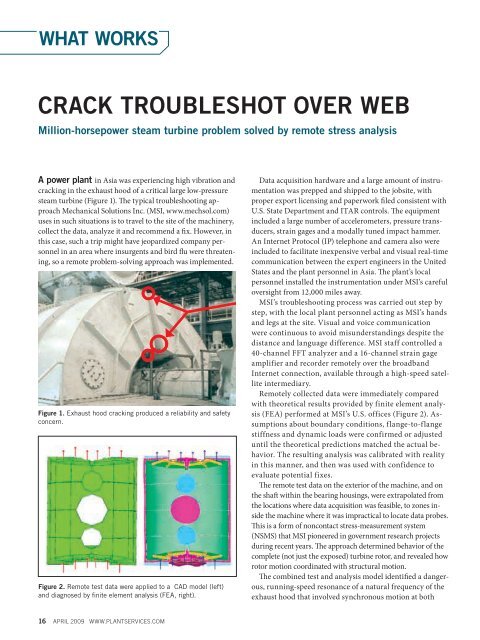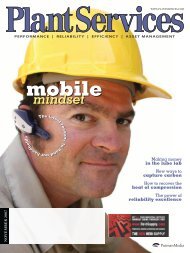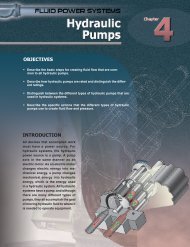POWER UP A WINNER - Plant Services
POWER UP A WINNER - Plant Services
POWER UP A WINNER - Plant Services
Create successful ePaper yourself
Turn your PDF publications into a flip-book with our unique Google optimized e-Paper software.
what works<br />
Crack Troubleshot Over Web<br />
Million-horsepower steam turbine problem solved by remote stress analysis<br />
A power plant in Asia was experiencing high vibration and<br />
cracking in the exhaust hood of a critical large low-pressure<br />
steam turbine (Figure 1). The typical troubleshooting approach<br />
Mechanical Solutions Inc. (MSI, www.mechsol.com)<br />
uses in such situations is to travel to the site of the machinery,<br />
collect the data, analyze it and recommend a fix. However, in<br />
this case, such a trip might have jeopardized company personnel<br />
in an area where insurgents and bird flu were threatening,<br />
so a remote problem-solving approach was implemented.<br />
Figure 1. Exhaust hood cracking produced a reliability and safety<br />
concern.<br />
Figure 2. Remote test data were applied to a CAD model (left)<br />
and diagnosed by finite element analysis (FEA, right).<br />
Data acquisition hardware and a large amount of instrumentation<br />
was prepped and shipped to the jobsite, with<br />
proper export licensing and paperwork filed consistent with<br />
U.S. State Department and ITAR controls. The equipment<br />
included a large number of accelerometers, pressure transducers,<br />
strain gages and a modally tuned impact hammer.<br />
An Internet Protocol (IP) telephone and camera also were<br />
included to facilitate inexpensive verbal and visual real-time<br />
communication between the expert engineers in the United<br />
States and the plant personnel in Asia. The plant’s local<br />
personnel installed the instrumentation under MSI’s careful<br />
oversight from 12,000 miles away.<br />
MSI’s troubleshooting process was carried out step by<br />
step, with the local plant personnel acting as MSI’s hands<br />
and legs at the site. Visual and voice communication<br />
were continuous to avoid misunderstandings despite the<br />
distance and language difference. MSI staff controlled a<br />
40-channel FFT analyzer and a 16-channel strain gage<br />
amplifier and recorder remotely over the broadband<br />
Internet connection, available through a high-speed satellite<br />
intermediary.<br />
Remotely collected data were immediately compared<br />
with theoretical results provided by finite element analysis<br />
(FEA) performed at MSI’s U.S. offices (Figure 2). Assumptions<br />
about boundary conditions, flange-to-flange<br />
stiffness and dynamic loads were confirmed or adjusted<br />
until the theoretical predictions matched the actual behavior.<br />
The resulting analysis was calibrated with reality<br />
in this manner, and then was used with confidence to<br />
evaluate potential fixes.<br />
The remote test data on the exterior of the machine, and on<br />
the shaft within the bearing housings, were extrapolated from<br />
the locations where data acquisition was feasible, to zones inside<br />
the machine where it was impractical to locate data probes.<br />
This is a form of noncontact stress-measurement system<br />
(NSMS) that MSI pioneered in government research projects<br />
during recent years. The approach determined behavior of the<br />
complete (not just the exposed) turbine rotor, and revealed how<br />
rotor motion coordinated with structural motion.<br />
The combined test and analysis model identified a dangerous,<br />
running-speed resonance of a natural frequency of the<br />
exhaust hood that involved synchronous motion at both<br />
16 APRIL 2009 www.PLANTSERVICES.com












